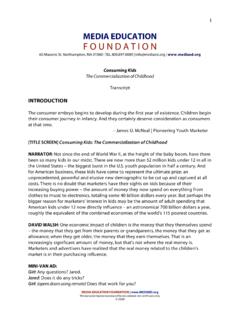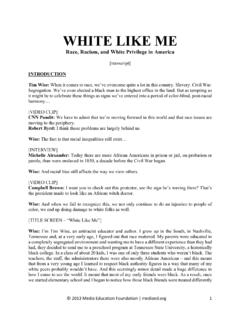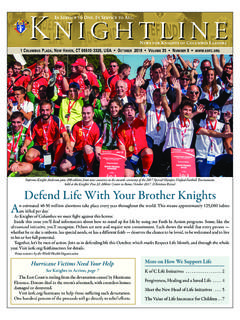Transcription of MEDIA EDUCATION FOUNDATION TRANSCRIPT
1 TOUGH GUISE: FULL VERSIONVIOLENCE, MEDIA & THE CRISIS IN MASCULINITYMEDIA EDUCATIONFOUNDATIONTRANSCRIPTC hallenging mediaTOUGH GUISEV iolence, MEDIA & the Crisis in Masculinity(FULL LENGTH version)Executive Producer & Director: Sut JhallyProducers: Susan Ericsson & Sanjay TalrejaWritten by: Jackson Katz & Jeremy EarpEditors: Sut Jhally, Susan Ericsson, Sanjay Talreja & Jeremy SmithFeaturing an interview with Jackson Katz Anti-Violence EducatorMedia EDUCATION FOUNDATION MEF 19992 INTRODUCTION[Montage of images and clips from mainstream entertainment and news MEDIA ]-- We re going to murder those lousy Hun bastards by the Never show weakness. The only pain that matters is the pain you It s the roughest and toughest show on TV: The American You gotta out-tough people when you get down there, its man-on-man out Police say boys ages thirteen and eleven were arrested near the school carrying guns andwearing Two in three million Americans are battered in their home every [Pearl Jam song: Better Man]Talkin to herself, there s no one else who needs to tells herself, back when she was bold and strongAnd waiting for the world to come she knew it, now she swears he s goneShe lies and says she s in love with him, can t find a better dreams in color, she dreams in red, can t find a better lies and says she still loves him, can t find a better dreams in color, she dreams in red, can t find a better t find a better [Movie.]
2 The Wizard of Oz]Oz has spoken!-- Who are you?I am the great and powerful Wizard of You re a very bad no, my dear, I m a very good man. I m just a very bad KATZ: The climactic scene where Toto pulls back the curtain to reveal anervous, tragic man, pretending to be the great and powerful Oz, represents more than justthe classic moment in American cinematic history, rather, it also gave us a metaphor forlooking at masculinity in a new way. Not as a fixed, inevitable state of being, but rather as aprojection, a pose, a guise, an act, a mask that men often wear to shield our vulnerabilityand hide our mask can take a lot of forms but one that s really important for us to look at in ourculture at the millennium is what I call the Tough Guise. The front that many men put upthat s based on an extreme notion of masculinity that emphasizes toughness and physicalstrength and gaining the respect and admiration of others through violence or the implicitthreat of and young men learn early on that being a so-called "real man" means you have totake on the "tough guise," in other words you have to show the world only certain parts of3yourself that the dominant culture has defined as manly.
3 You can find out what thosequalities are if you just listen to young men themselves:YOUNG MEN:-- A real man is In Scares A A real man is KATZ: And just as most young men know what our culture expects of a "realman," they also know very well what you get called if you don t measure up:YOUNG MEN:-- You get a called a A A You re a little momma s A You get called A A You re a KATZ: So for boys, and this is true for every racial and ethnic background, andevery socioeconomic group, to be a real man to be tough, strong, independent, respected4 means fitting into this narrow box that defines manhood. The terms that are the oppositeof that: wuss, wimp, fag, sissy are insults that are used to keep boys boxed in, so if you're aboy it's pretty clear there's a lot of pressure on you to conform, to put up the act, to be justone of the the next question is, where do boys learn this?
4 Obviously they learn it in many differentplaces. They learn it from their families, their community, but one of the most importantplaces they learn it is the powerful and pervasive MEDIA system which provides a steadystream of images that define manhood as connected with dominance, power and is true across all racial and ethnic groups but it s even more pronounced for men ofcolor because there s so little diversity of images for them, to begin with for example,Latino men are almost always presented either as boxers, criminals, or tough guys in thebarrio, and Asian-American men are disproportionately portrayed as martial artists andviolent transcending race, what the MEDIA do is help to construct violent masculinity as acultural norm. In other words, violence isn t so much a deviation, but an accepted part ofmasculinity.
5 We have to start examining this system, and offering alternatives because oneof the major consequences of all of this, is that there s been a growing connection made inour society between being a man and being violent. In fact, some of the most seriousproblems in contemporary American society, especially those connected with violence, canbe looked at as essentially problems in contemporary American example, over 85% of the people who commit murder, are men, and the women that do,often do so as defense against men who are battering them. Ninety percent of people whocommit violent physical assault are men. Ninety-five percent of serious domestic violence isperpetrated by males, and its been estimated that one in four men will use violence againsta partner in their lifetime. Over 95% of dating violence is committed by men, and very oftenit s young men in their teens.
6 Studies have found that men are responsible for between 85%and 95% of child sexual abuse whether the victim is female or male. And of people inprison convicted of rape, are this shows is that an awful lot of boys and men are inflicting an incredible level of painand suffering, both on themselves and on others. And we know that much of the violence iscyclical, that many boys who are abused as children grow up and become perpetratorsthemselves. So calling attention to the way that masculinity is connected to these problemsis not anti-male it s just being honest about what s going on in boys and men s lives. Andwhile women have been at the forefront of change and trying to talk about these issues inthe culture, it s not just women who will benefit if men s lives are transformed. In fact, whilemen commit a shameful level of violence against women in our society, statisticallyspeaking, the major victims of men s violence are other males.
7 There are millions of maletrauma survivors walking around today, men who were bullied as adolescents, or abusedphysically or sexually as children. Thousands more men and boys are murdered orassaulted every year usually by other men. So, men have a stake in dealing with theseproblems, and not just those of us who have been victims, but also those men who areviolent, or who have taken on the tough guise, they do so also at the expense of theiremotional and relational [Young woman] Some of my friends, they just walk around like they re better thaneverybody, and their tough and all that stuff. And then I ll be alone with them, and they ll belike the biggest babies. If they have like a problem with a girlfriend or something, they ll belike crying and stuff, but when they re around a lot of people they ve got that big front,they ve gotta be KATZ: I deal with this front all the time in my own work as an anti-violenceeducator.
8 I ve worked with literally thousands of boys and men on high school, college, andprofessional sports teams, in the United States military, in juvenile detention centers. I veseen an awful lot of men and young men put on this tough guise. In many ways, they reputting it on as a survival mechanism they have to do it to survive in whatever peer culturethey happen to be in. But putting on the tough guise comes with a cost and that is a cost interms of damage to their psyches and their ability to be decent human beings. So it s ineveryone s interest to examine masculinity, to pull back the curtain on the tough guy posing,and see what s really going on underneath.[Movie: Raging Bull]I want you to hit me with everything you ve You sure?Yeah. Harder. Harder. Harder. That s What are you trying to prove? What does it prove?
9 6 PART ONE: UNDERSTANDING VIOLENT MASCULINITYHIDDEN A Gender[News] There is more details and a profile developing of kids who kill KATZ: One of the things that happens in typical discussions about socialproblems is that the very way we talk about the problems, tends to obscure some of the rootcauses. For example, violence is not typically talked about as a gender issue, but the fact isthat one gender, men, perpetrate approximately 90% of the violence. Now part of the reasonfor this is because men are the dominant group. And one of the ways dominance functions isthrough being unexamined. This is true for other areas as example, when we hear the word race in the United States we tend to immediately thinkAfrican American, Latino, Asian American, Native American, etc. When we hear the termsexual orientation, we tend to think gay, lesbian, bisexual, transgender.
10 When we hear theterm gender, we tend to think women. In each case the dominant group, white people,heterosexual people, men, don't get examined. As if men don't have a gender. As if whitepeople don't belong to some racial grouping. As if heterosexual people don't have some sortof sexual orientation. In other words we focus always on the subordinated group and not onthe dominant group. And that s one of the ways that the power of dominant groups isn tquestioned by remaining s a number of ways that this happens. For example, the linguist Julia Penelope talksabout how the use of the passive voice when we talk about crimes against women, tends toshift our focus off of male perpetrators and on to female victims and survivors. For examplewe talk about how many girls were raped last year. How many women were assaulted?
![Advertising at the Edge of the Apocalypse [Transcript]](/cache/preview/d/e/7/c/d/b/4/6/thumb-de7cdb46ab24a926068f936b79251872.jpg)
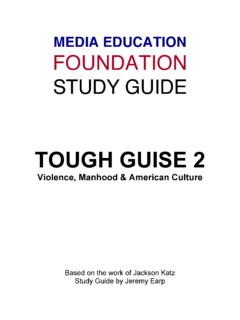
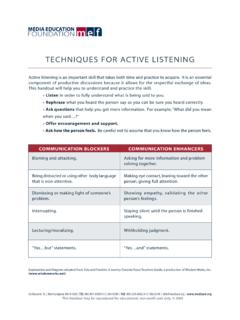
![Tough Guise 2 [Official Transcript] - Media Ed](/cache/preview/c/3/b/5/2/d/3/e/thumb-c3b52d3e6a3437c17d6d8ad6485bd936.jpg)
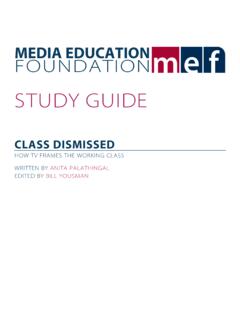

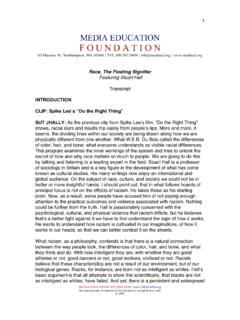
![Requiem For The American Dream [Transcript]](/cache/preview/a/b/8/4/f/8/1/2/thumb-ab84f812664524b6923d6df2929c06cf.jpg)
